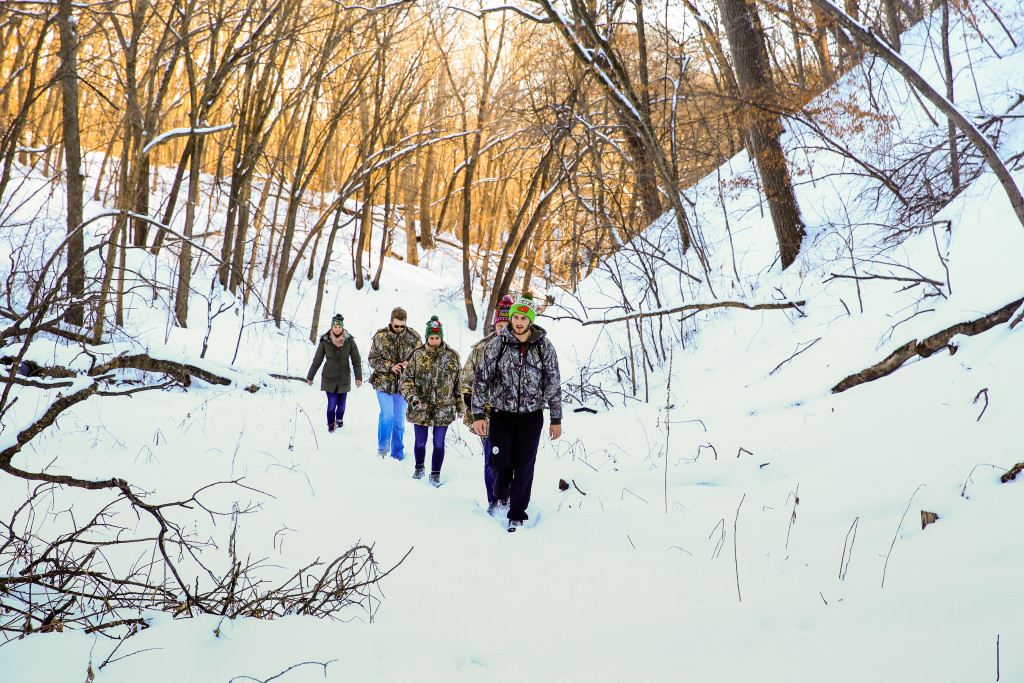
By Monica Macoubrie, Wildlife Education Specialist
For many hikers, spring or fall is the prime time to be out in nature. But the truth is, anytime is a good time to be outside — even in the winter!
As the days get shorter and the weather gets more iffy, it’s easy to lose motivation to get outside. While hunkering down in front of a TV might seem like the more attractive thing to do, know that hiking in the winter can be just as fun as hiking in the warmer months. Getting out in nature is a great form of exercise, improves your mental health and boosts your mood. Winter is also an opportune time to view wildlife.
Whether you love winter or hate it, we want everyone to feel comfortable getting outside and enjoy what Nebraska has to offer. Here are a few tips:
Plan, Plan and Plan Again
I’m a planner, but I get that not everyone has five calendars and uses alarm clock reminders. However, if you are going to be hiking in the winter, you have to make planning a priority. Everything takes longer to accomplish in the winter, so there will be a few more factors to consider than if you were planning a regular, warm-weather hiking excursion.
Always check trail conditions to make sure you can get to and from the trailhead safely. The app AllTrails is useful because it provides information on nearly every trail across the U.S. and trail reviews from real hikers on how the conditions are, even in remote areas of Nebraska.
Also remember that daylight hours are shorter, so hit the trail early to avoid having to find your way back in the dark. Winter hiking will also take longer, especially if there is heavy or thick snow on the ground, so plan accordingly. If you’re out hiking in the cold, remember that most technology isn’t built for extreme temperatures. Bring extra batteries, and don’t rely on your cell phone alone. Tell someone where you are going before leaving the house.
Having a plan also means knowing the weather forecast. Always plan for the worst. Whiteout conditions, a snowstorm, plummeting temperatures — conditions can change in a hurry. To avoid these dangerous situations, always keep up-to-date on the forecast. If the weather gets treacherous or the hike is taking longer than expected, don’t be afraid to turn around early to make it back to your vehicle before nightfall. Be smart out there and know when it’s safest to abandon mission. You can always try again another day.
Dress for the Season
Winter hiking is a little bit more complicated than simply throwing on hiking boots and heading out the door. Depending on the time-of-day, winter temperatures can change quickly. To avoid getting caught unprepared, dress in layers. You can always take off layers, but you can’t add on layers if you don’t have them in the first place. Here are a few items to consider wearing or bringing extras:
- Heavyweight socks
- Two pairs of gloves or mittens
- Waterproof outer layers
- Stocking cap or a jacket with a hood
- Fleece or wool mid- and base layers
Hydrate and Stay Nourished
Staying hydrated and well-nourished is important even in the dead of winter. While drinking water may not seem as necessary when you’re cold, dehydration is actually a common problem in the winter. Exercising in the winter burns more calories as your body works extra hard to maintain a steady core temperature. This means you will need to eat and drink more frequently to maintain your energy. If you do become dehydrated, hypothermia has a better chance of setting in, which could then turn into an emergency.
Always Hike with a Partner
The buddy system can apply to any outdoor situation, but it’s especially relevant in the winter. Whether it’s missing a trail sign or getting caught in the darkness, a partner can help you avoid common mistakes that could lead to a disaster. If disaster does strike, an extra pair or eyes and hands will help the both of you get out of it.
Take a few extra precautions and hiking in the winter can be just as fun as hiking in any other season.
